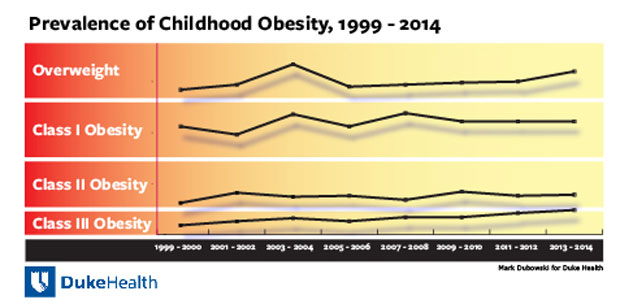Obesity Rates in US Kids Still Rising, Study Says

Despite reports that childhood obesity may be declining in some parts of the United States, a new study suggests that childhood obesity is still on the rise nationwide.
In particular, there has been an increase in the percentage of children with severe obesity, the study found.
From 2013 to 2014, 6.3 percent of U.S. children ages 2 to 19 had a body mass index (BMI) of at least 35, which is considered to be severely obese. That's up from 5.9 percent in the years 2011 to 2012.
And, in 2013 to 2014, the percentage of children with a BMI of 40 or more (known as "severe obesity, class 3") also rose, increasing from 2.1 percent in 2011 to 2012, and to 2.4 percent in 2013 to 2014, the study found.
"An estimated 4.5 million children and adolescents have severe obesity and they will require new and intensive efforts to steer them toward a healthier course," study co-author Asheley Skinner, an associate professor of medicine at Duke University, said in a statement. "Studies have repeatedly shown that obesity in childhood is associated with worse health and shortened lifespans as adults."
For the new study, the researchers analyzed information from a national survey on U.S. children who had their height and weight measured to calculate their BMI.
Overall, 17.4 percent of U.S. children ages 2 to 19 were obese in 2013 to 2014. That’s about the same as the percentage who were obese in the years 2011 to 2012. But when the researchers looked at the trend in obesity rates from 1999 to 2014, they saw a clear and sustained increase in all levels of obesity during that time period. [10 Ways to Promote Kids' Healthy Eating Habits]
Get the world’s most fascinating discoveries delivered straight to your inbox.
Previous studies had reported that childhood obesity rates in some cities, and in some age groups, were on the decline. For example, a 2014 study from the Centers for Disease Control and Prevention found that obesity rates in U.S. kids ages 2 to 5 declined 43 percent from 2003 to 2004 to 2011 to 2012.
But the researchers in the new study did not see this same decline when they looked at information from 1999 through 2014.
"There is no specific time frame that can be considered ideal for tracking changes [in obesity]; only through consistent monitoring over time can transient dips or peaks in prevalence be sorted out," the researchers said.
The researchers noted that the new study was broader than previous studies because it included children across the country, and in most age groups.
Additional studies will be needed to see whether the apparent stagnation of childhood obesity rates in 2011 to 2012 and 2013 to 2014 represented a real leveling off, or if obesity rates will continue to rise, the researchers said.
The study is published today (April 26) in the journal Obesity.
Follow Rachael Rettner @RachaelRettner. Follow Live Science @livescience, Facebook & Google+. Original article on Live Science.

Rachael is a Live Science contributor, and was a former channel editor and senior writer for Live Science between 2010 and 2022. She has a master's degree in journalism from New York University's Science, Health and Environmental Reporting Program. She also holds a B.S. in molecular biology and an M.S. in biology from the University of California, San Diego. Her work has appeared in Scienceline, The Washington Post and Scientific American.
